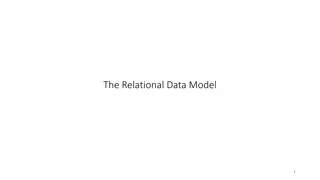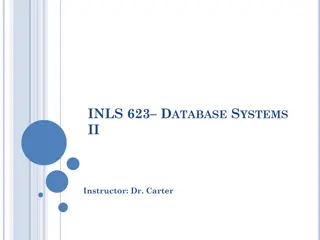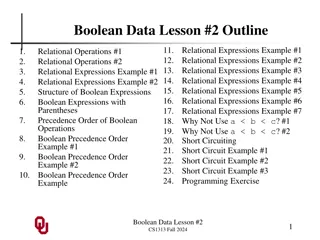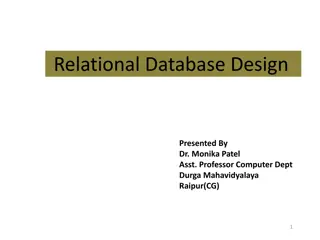Understanding Integrity Constraints in Relational Database Systems
Integrity constraints play a crucial role in maintaining the accuracy and integrity of data in a database. They include domain constraints, entity integrity, and referential integrity, each serving a specific purpose to ensure data consistency and reliability. Domain constraints ensure values in a column belong to the same domain, entity integrity guarantees the validity of primary key values, and referential integrity establishes relationships between tables using foreign keys. Well-structured relations minimize redundancies to prevent anomalies like insertion, deletion, and modification errors.
Download Presentation

Please find below an Image/Link to download the presentation.
The content on the website is provided AS IS for your information and personal use only. It may not be sold, licensed, or shared on other websites without obtaining consent from the author. Download presentation by click this link. If you encounter any issues during the download, it is possible that the publisher has removed the file from their server.
E N D
Presentation Transcript
Database Systems Instructor: Sadiq Shah (Lecture 10)
INTEGRITY CONSTRAINTS The relational data model includes several types of constraints, or rules limiting acceptable values and actions, whose purpose is to facilitate maintaining the accuracy and integrity of data in the database. The major types of integrity constraints are Domain constraints, Entity integrity, and Referential integrity.
INTEGRITY CONSTRAINTS Domain Constraints All of the values that appear in a column of a relation must be from the same domain. A domain is the set of values that may be assigned to an attribute. E.g Data type, Size, allowable range
INTEGRITY CONSTRAINTS Entity Integrity The entity integrity rule is designed to ensure that every relation has a primary key and that the data values for that primary key are all valid. In particular, it guarantees that every primary key attribute is non- null. Null A value that may be assigned to an attribute when no other value applies or when the applicable value is unknown. In reality, a null is not a value, but rather it indicates the absence of a value
INTEGRITY CONSTRAINTS Referential Integrity In the relational data model, associations between tables are defined through the use of foreign keys. For example, in Figure 4-4, the association between the CUSTOMER and ORDER tables is defined by including the CustomerID attribute as a foreign key in ORDER. This of course implies that before we insert a new row in the ORDER table, the customer for that order must already exist in the CUSTOMER table.
Referential Integrity Example
Well-structured relation-I A relation that contains minimal redundancy and allows users to insert, modify, and delete the rows in a table without errors or inconsistencies. Redundancies in a table may result in errors or inconsistencies (called anomalies) Anomaly An error or inconsistency that may result when a user attempts to update a table that contains redundant data. The three types of anomalies: Insertion Anomaly Deletion Anomaly Modification anomaly 1. 2. 3.
Well-structured relation-II Insertion anomaly: Suppose that we need to add a new employee to EMPLOYEE2. The primary key for this relation is the combination of EmpID and CourseTitle (as noted earlier). Therefore, to insert a new row, the user must supply values for both EmpID and CourseTitle (because primary key values cannot be null or non-existent).
Well-structured relation-III Deletion anomaly: Suppose that the data for employee number 140 are deleted from the table. This will result in losing the information that this employee completed a course (Tax Acc) on 12/8/201X. In fact, it results in losing the information that this course had an offering that completed on that date.
Well-structured relation-IV Modification/Update anomaly: Suppose that employee number 100 gets a salary increase. We must record the increase in each of the rows for that employee (two occurrences in Figure given); otherwise, the data will be inconsistent.























